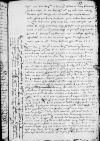Letter #1589
[Ioannes DANTISCUS] to [Georg von BAYSEN (BAŻYŃSKI)]Löbau (Lubawa), 1537-03-15
English register: Dantiscus has received Bażyński’s letter (IDL 1585). He is sending him a copy of his letter to the king (IDL 1602), confirmed by the seal of Maurycy Ferber. Dantiscus promises to inform Bażyński immediately about the king’s reply.
Manuscript sources:
Prints:
| ||||||
Text & apparatus & commentary Plain text Text & commentary Text & apparatus
Magnifice Domine, Amice carissime et honoran(de) or honoran(dissim)e⌈honoran(de)honoran(de) or honoran(dissim)e⌉. Salutem et omnem felicitatem.
Ista hora accepi Magnificentiae Vestrae cf.
Datum

 BCz, 244, p. 197
BCz, 244, p. 197